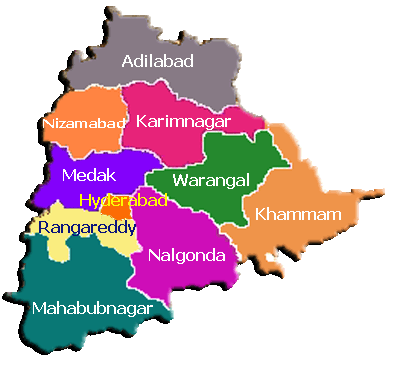What is Telagana?
The Telangana Issue:-
What is Telagana?
Telangana is a region in Andhra Pradesh and was
originally a princelystate, ruled by the erstwhile Nizam of Hyderabad.
Andhra Pradesh todayas it stands, can be divided into three regions‘
Telangana, Rayalaseemaand Coastal Andhra.
The Telangana region comprises of districts in Western and Central
Andhra Pradesh (Adilabad, Karimnagar, Nizamabad, Medak,
Warangal,Khammam, Hyderabad, Rangareddy, Nalgonda, and Mahaboobnagar)
Itcomprises 10 of Andhra Pradesh’s 23 districts. It accounts for 119
seats out of the 294 seats in Assembly.
Telegana at the time of Independence:-
After Independence, the Nizam of Hyderabad wanted to
retain his hold over the state. But the Government of India had other
plans and amalga-mated his state on 17th September 1948 by force.
On a historic note, Rayalseema and Coastal Andhra were part of the
Madras Province under the British Empire. However post independence
Rayalaseema and Coastal Andhra were separated from the Madras State
in 1953 and were merged with the Telangana region of Hyderabad in 1956 to form the state of Andhra Pradesh.
The remaining parts of the Telangana region were merged with Karnataka
and Maharashtra. This was the first state that was carved out on
linguistic lines in the country.
Demands for a separate Telangana State:-
Demands for carving out a separate Telangana State became more buoyant during 1969. There are quite a few reasons for this:-
(!)There were distinct differences between Telangana and Andhra Re-gions.
(!!)Andhra
that was initially a part of Madras presidency had much better
standards of development and education. Telangana on the other hand was
more feudal in its approach and much less developed.
(!!!)he Telangana people had reservations also because they feared they would lose out on many jobs with the merger
(!v)he cultural differences too were apparent. Under the rule of the Ni-
zam the Telangana region bore influences of Northern India. The kind of festivals being celebrated too was different.
The 1969 AgitationThis was primarily a student protest which erupted in the region.
The 1969 Agitation:-
This was primarily a student protest which erupted in the
regions of Telangana with Osmania Univeristy proving to be the hot bed
of it all. The protests became massive with huge numbers of people
taking part in the agitation.
Over 350 people lost their lives in
lathi charge and police firing. Former Congress leader Channa Reddy who
defected to form his own party the‘Telangana Praja Samithi’ later
diluted the impact of the agitation as hemerged with the Congress.
Channa Reddy was also the same person responsible for raising slo-gans like ‘Jai Telangana’. The Prime Minister Indira Gandhi later went on
to make him the Chief Minister after which the movement collapsed.
After this P.V Narasimha Rao was also made the Chief Minister in 1971.He was also from the Telangana region.
The role of K Chandrasekhar Rao:-
K Chandrasekhar Rao was a member of the Telugu Desam
Party (TDP) during the 1990’s. While hoping for a ministerial birth he
only got that of a deputy speaker following the 1999 elections.
KCR quit TDP in 2001 and set about to form the Telangana Rashtra Samithi (TRS) which he announced would fight for the formation of a
separate
Telangana State. The timing could not have been more perfect for KCR
considering the fact the people of Telangana were already feeling
looted.
In the elections of 2004 YS Rajashekara Reddy and KCR decided to join
hands after YSR promised him the formation of a separate Telan-gana
State. But later YSR backtracked and sent a report to the Congress
against the formation of the Telangana State.
On November 29, 2009, KCR took
a fast until death demanding that the Congress Government introduce the
Telangana bill in the parliament.Student’s rallies and people from
various organizations took part in thedemands and there were massive
protests in many regions of Telan-gana.
With KCR’s health fast
failing the centre was forced to look into issueand finally gave into
his request of a separate state making KCR end his11 day fast.
Srikrishna committee
headed by Justice BN Srikrishna was then setup to look into wether a
separate state should be carved out or a united Andhra must remain.
The committee was constituted by the Government of India in 3 Febru-ary
2010 and expected to submit its report on 30 December 2010 to the
Ministry of Home Affairs.
As part of the committee they invited
people from all sections of the society and also toured the entire state
where they got the opinions of a lot of people on what they felt about
the issue. The SriKrishna Report was released on the internet to the
public on 6 January 2011.
The issue is still being contemplated in the political circles.
These two papers are the only changes that have been introduced by the
government which will be enforced from next year onwards that is 2011.
The rest of the pattern will remain the same as before. The aspirants
clearing these two examinations will then be short listed for the main
exam and then the interviews which will be followed after giving the
main exams.
The pattern for the main exam and the interview will remain the same
until next year or in other words next year would be more or less a
trial basis for a new pattern.
If the government feels that there is a need for change in pattern of
the main exam as well as the interview then it will be considered after
next year. As of now the two aptitude tests are the only main changes
in the civil services examination.
These changes are definitely for the better as this pattern will give
more people the encouragement and hope that civil services is not next
to impossible and there is chance for even the average hard working
people.
It is hoped that more number of people will be able to clear
the papers so that a fair chance is given to all of them to prove
themselves.

No comments:
Post a Comment